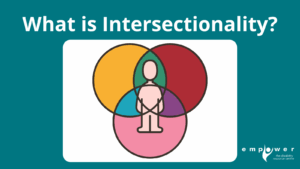The Importance of Intersectionality
August 29, 2025

What is intersectionality and why is it important?
Intersectionality means that social identities like race, gender, age, sexual orientation, geographic location and financial status are connected and that when they overlap in a person’s life, they can create extra challenges or discrimination.
Intersectionality can significantly impact a person’s experience of their disability by creating unique challenges and barriers at the intersection of multiple social identities.
When we understand how different types of discrimination are connected, we can break down the systems that cause these disadvantages and create a more fair and inclusive society where everyone’s experiences matter.
Beginning with Gender, women with disabilities often face a double burden of discrimination, experiencing sexism and ableism. This can manifest as barriers to healthcare, employment, and participation in society.
Sexual Orientation and Gender Identity can cause 2SLGBTQIA+ individuals with disabilities to face unique challenges due to homophobia, transphobia, and ableism. This can include discrimination in healthcare, housing, and other essential services.
Further intersections with disability are Race, Ethnicity and Religious Beliefs.
People with disabilities from racial, ethnic and religious minority groups may experience compounded discrimination due to both racism/religious intolerance and ableism. This can lead to disparities in access to healthcare, education, and employment opportunities.
Two more forms of intersectionality with disability are Socioeconomic Status and Age.
Individuals with disabilities who also live in poverty may face additional barriers to accessing essential resources like healthcare, transportation, and assistive technology. This can create a cycle of poverty and disability, further limiting opportunities.
Ageism can intersect with disability, leading to negative stereotypes and assumptions about the abilities of both older adults and young people with disabilities. This can impact access to services, employment, and social participation.
Another two types of intersections with disability are Geographic Location and Culture/Language.
People with disabilities in rural or remote areas may experience limited access to specialized healthcare, support services, and transportation. This can further exacerbate the challenges associated with disability.
Disabled people from culturally and linguistically diverse backgrounds may face additional barriers due to language differences and cultural misunderstandings. This can impact access to healthcare, education, and social services.
So why is Intersectionality important?
Because disability doesn’t exist in isolation.
People with disabilities also have identities connected to race, gender, culture, language, sexual orientation, and more. All of these parts of who we are shape our experiences in the world.
When policies and practices ignore these intersections, some voices get left out — and inequality grows. But when we take them into account, we can create a society that is fairer, more inclusive, and responsive to the real needs of people with disabilities.
Because inclusion means seeing the whole person. 💙